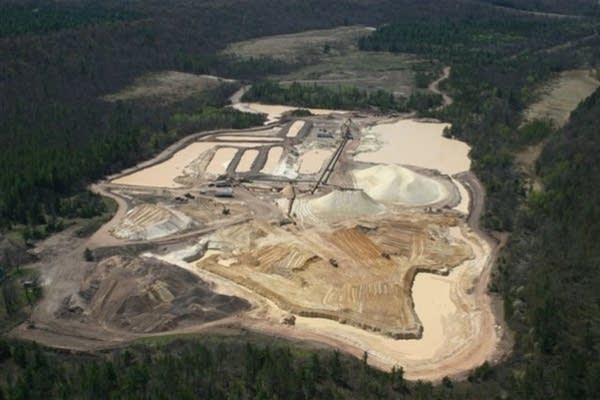Frac sand sediment spills into St. Croix River
Go Deeper.
Create an account or log in to save stories.
Like this?
Thanks for liking this story! We have added it to a list of your favorite stories.

A spill at a sand mining facility in Wisconsin has dumped an unknown amount of sand and other sediment into the St. Croix River and wetlands near the Minnesota border, the Wisconsin Department of Natural Resources confirmed Thursday.
The sand-laden water may have harmed aquatic life, but DNR officials said it's too soon to know the extent of the damage. They plan to conduct a full investigation with the assistance of the U.S. Army Corps of Engineers, the U.S. National Park Service, and Burnett County Conservation officials.
"I'm sure there were things living there that are going to have difficulty living there now that they're covered with sand," said Tom Woletz, a senior manager at the Wisconsin DNR who specializes in sand mining and other industries related to hydraulic fracking.
Conservation officials first learned of the leak on April 22, when a hiker reported seeing cream-colored water in a creek flowing to the St. Croix River. DNR investigators used a plane to survey the area four days later. They traced the murky water back to a 72-acre sand mining facility operated by Maple Grove-based Tiller Corporation, where they located a leak in one of the facility's holding ponds. The company was notified and agreed to repair the pond immediately, according to DNR officials and Tiller Corporation's land use affairs director Mike Caron.
Turn Up Your Support
MPR News helps you turn down the noise and build shared understanding. Turn up your support for this public resource and keep trusted journalism accessible to all.
Caron said he doesn't know how mine employees failed to notice the leak.
"I don't have an answer for that question," he said. "We've asked our people to do their inspections. Somehow this one got missed by them."
The sand mining facility is part of a fast-growing "sand rush" in rural Wisconsin, driven by the petroleum industry's demand for pure, round-shaped sand to use to help extract oil and natural gas from the ground. The technique, known as hydraulic fracking, works by blasting water, sand, and chemicals into the ground to break up shale rock formations and release oil and natural gas deposits. Wisconsin is home to one of the largest known deposits of the specific kind of sand most prized by the petroleum industry. A "conservative estimate" released by the DNR in January said the state could produce more than 12 million tons of frac sand per year.
The rapid growth has left state and local officials scrambling to oversee the industry. Two years ago, Wisconsin had five frac sand mines and five processing facilities. Now it has 63 mines and 36 processing facilities, according to current DNR figures.

County officials are responsible for approving new mine sites, but they are not required to regularly inspect the facilities, said Burnett County Conservationist Dave Ferris.
"We go out on an occasional basis," Ferris said. "We did not have any particular inspection regime in our permit."
Ferris said he plans to increase inspections at the site, which is the county's only frac sand mine.
In the last 12 months, there have been six spills at frac sand sites in Wisconsin, Woletz said. The leaks are usually caused by a problem in the washing process, he said. The mines wash the sand to separate out the best sizes and shapes and rinse off dirt and other sediment. State law requires the mines to obtain permits if they plan to discharge the excess sand and sediment off-site.
However, in the case of the Tiller facility, DNR officials said, it was registered as an internally draining site.
"What that means is that all run-off is just supposed to stay in a hole in the ground," said DNR storm water specialist Ruth King, who inspected the facility when it opened last year.
Sites with internal drainage are required to create a storm water run-off plan, but they are not required to show the plan to the DNR before the department issues a permit, King said.

"The thought being, if the rain drop is just going in a hold in the ground, what's the big deal?" she said.
King said the company did not inform the department when it built holding pools on the site. Caron, of the Tiller Corporation, said the pool that leaked was built in April.
The facility's operations may have violated two state regulations, said DNR enforcement officer Deb Dix. They include "discharging off-site without a permit and failure to maintain physical controls to prevent the discharge of storm water," Dix said via email Thursday. The DNR is still collecting data and has not made a final decision about whether the facility will face fines or other sanctions, she said. The affected area includes National Park land, and officials are still sorting out which agencies have jurisdiction over the incident, she said.
Jill Medland, environmental coordinator at the St. Croix National Scenic Riverway, said the incident shows the danger of allowing a sand mining facility so close to a pristine waterway.
"It seems that there's such a demand for frac sand that things are getting permitted quickly without full environmental review, and then things happen that should or could have been avoided," she said.
Medland said she won't forget the photos of the muddy water anytime soon.
"When there's water the color of coffee with a lot of cream in it flowing into the St. Croix River, it's very disconcerting," she said.
Dear reader,
Political debates with family or friends can get heated. But what if there was a way to handle them better?
You can learn how to have civil political conversations with our new e-book!
Download our free e-book, Talking Sense: Have Hard Political Conversations, Better, and learn how to talk without the tension.




